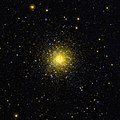NGC 1851
|
Globular cluster NGC 1851 |
|
|---|---|

|
|
| Photo from the Hubble Space Telescope | |
| AladinLite | |
| Constellation | Dove |
|
Position equinox : J2000.0 , epoch : J2000.0 |
|
| Right ascension | 05 h 14 m 06.7 s |
| declination | -40 ° 02 ′ 48 ″ |
| Appearance | |
| Brightness (visual) | 7.1 likes |
| Angular expansion | 12 ' |
| Physical data | |
| Affiliation | Milky Way ( Canis Major Dwarf Galaxy ) |
| Integrated spectral type | F7 |
| Redshift | +0.001071 ± 0.000003 |
| Radial velocity | +320.9 ± 1.0 km / s |
| distance | about 12,000 pc |
| Absolute brightness | V-band: −8.3 mag |
| history | |
| discovery | James Dunlop |
| Discovery date | May 10, 1826 |
| Catalog names | |
| NGC 1851 • C 0512-400 • GCl 9 • ESO 305-SC16 • Dun 508 • GC 1061 • h 2777 | |
NGC 1851 is the name of a globular cluster in the constellation Columba . NGC 1851 is 12 arc minutes in diameter . This cluster, which is only visible from southern Europe or more southern latitudes, is one of the few globular clusters in the winter sky. This fact became even more explosive with the discovery of the Canis Major dwarf galaxy in 2003 . Just like Messier 79 and NGC 2808 , this star cluster does not seem to have its origin in the Milky Way system, but was captured along with that dwarf galaxy.
The object was discovered in 1826 by the Scottish astronomer James Dunlop .
Ultraviolet photography of NGC 1851 taken by GALEX

